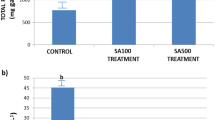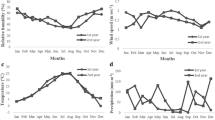Abstract
The effects of exogenous abscisic acid (ABA) on phenolic characteristics of grapes and wines were investigated in Vitis vinifera cvs. Merlot and Cabernet Sauvignon. Exogenous ABA treatment at veraison significantly improved phenolic contents, mainly anthocyanins and flavonols, and antioxidant properties of the grape skins, but had no effects on total phenolics and antioxidant activities in the seeds or on basic fruit qualities. The wines made from ABA-treated grapes were also consequently enhanced in total phenolics, anthocyanins, flavonols and antioxidant activities. The proportions of methylated anthocyanins in the skins and acylated anthocyanins and derived pigments in the wines were decreased to some degree by exogenous ABA treatment. No distinct relationships were observed between ABA concentrations and phenolic characteristics, and the effects were observed even with 200 mg/L ABA. The results revealed that exogenous ABA applied at veraison offered opportunities to improve phenolic contents and nutritional values of grape skins and wines.
Similar content being viewed by others
References
Flamini R, Mattivi F, Rosso MD, Arapitsas P, Bavaresco L. Advanced knowledge of three important classes of grape phenolics: Anthocyanins, stilbenes and flavonols. Int. J. Mol. Sci. 14: 19651–19669 (2013)
Asen S, Stewart RN, Norris KH. Co-pigmentation of anthocyanins in plant tissues and its effects on colour. Phytochemistry 11: 1139–1144 (1972)
Chira K, Pacella N, Jourdes M, Teissedre P-L. Chemical and sensory evaluation of Bordeaux wines (Cabernet-Sauvignon and Merlot) and correlation with wine age. Food Chem. 126: 1971–1977 (2011)
Ribichaud JL, Noble AC. Astringency and bitterness of selected phenolics in wines. J. Sci. Food Agr. 53: 343–353 (1990)
Katalinic V, Možina SS, Skroza D, Generalic I, Abramoviè H, Miloš M, Ljubenkov I, Piskernik S, Pezo I, Terpinc P, Boban M. Polyphenolic profile, antioxidant properties and antimicrobial activity of grape skin extracts of 14 Vitis vinifera varieties grown in Dalmatia (Croatia). Food Chem. 119: 715–723 (2010)
Leibowitz A, Faltin Z, Perl A, Eshdat Y, Hagay Y, Peleg E, Grossman E. Red grape berry-cultured cells reduce blood pressure in rats with metabolic-like syndrome. Eur. J. Nutr. 53: 973–980 (2014)
Pezzuto JM. Grapes and human health: A perspective. J. Agr. Food Chem. 56: 6777–6784 (2008)
Deytieux C, Gagné S, L’Hyvernay A, Donèche B, Geny L. Possible roles of both abscisic acid and indol-acetic acid in controlling grape berry ripening process. J. Int. Sci. Vigne. Vin. 41: 141–148 (2007)
Leung J, Giraudat J. Abscisic acid signal transduction. Annu. Rev. Plant Biol. 49: 199–222 (1998)
Peppi MC, Fidelibus MW, Dokoozlian N. Abscisic acid application timing and concentration affect firmness, pigmentation, and color of ‘Flame Seedless’ grapes. HortScience 41: 1440–1445 (2006)
Jeong ST, Goto-Yamamoto N, Kobayashi S, Esaka M. Effects of plant hormones and shading on the accumulation of anthocyanins and the expression of anthocyanin biosynthetic genes in grape berry skins. Plant Sci. 167: 247–252 (2004)
Zhu L, Zhang Y-L, Deng J-J, L H-R, Lu J. Phenolic concentrations and antioxidant properties of wines made from North American grapes grown in China. Molecules 17: 3304–3323 (2012)
Cliff MA, King MC, Schlosser J. Anthocyanin, phenolic composition, colour measurement and sensory analysis of BC commercial red wines. Food Res. Int. 40: 92–100 (2007)
Xu C-M, Zhang Y-L, Cao L, Lu J. Phenolic compounds and antioxidant properties of different grape cultivars grown in China. Food Chem. 119: 1557–1565 (2010)
Jin Z-M, He J-J, Bi H-Q, Cui X-Y, Duan C-Q. Phenolic compound profiles in berry skins from nine red wine grape cultivars in northwest China. Molecules 14: 4922–4935 (2009)
Singleton VL, Rossi Jr. JA. Colorimetry of total phenolics with phosphomolybdicphosphotungstic acid reagents. Am. J. Enol. Viticult. 16: 144–158 (1965)
Benzie IFF, Strain JJ. Ferric reducing ability of plasma (FRAP) as a measure of antioxidant power: The FRAP assay. Anal. Biochem. 239: 70–76 (1996)
Li Z, Pan Q-H, Jin ZM, Mu L, Duan C-Q. Comparison on phenolic compounds in Vitis vinifera cv. Cabernet Sauvignon wines from five wine-growing regions in China. Food Chem. 125: 77–83 (2011)
Xu C, Zhang Y-L, Zhu L, Huang Y, Lu, J. Influence of growing season on phenolic compounds and antioxidant properties of grape berries from vines grown in subtropical climate. J. Agr. Food Chem. 59: 1078–1086 (2011)
Sandhu AK, Gray DJ, Lu J, Gu L. Effects of exogenous abscisic acid on antioxidant capacities, anthocyanins, and flavonol contents of muscadine grape (Vitis rotundifolia) skins. Food Chem. 126: 982–988 (2011)
Lacampagne S, Gagné S, Gény L. Involvement of abscisic acid in controlling the proanthocyanidin biosynthesis pathway in grape skin: New elements regarding the regulation of tannin composition and leucoanthocyanidin reductase (LAR) and anthocyanidin reductase (ANR) activities and expression. J. Plant Growth. Regul. 29: 81–90 (2010)
Owen SJ, Lafond MD, Bowen P, Bogdanoff C, Usher K, Abrams SR. Profiles of abscisic acid and its catabolites in developing Merlot grape (Vitis vinifera) berries. Am. J. Enol. Viticult. 60: 277–284 (2009).
Peppi MC, Fidelibus MW, Dokoozlian NK. Application timing and concentration of abscisic acid affect the quality of ‘Redglobe’ grapes. J. Hortic. Sci. Biotech. 82: 304–310 (2007)
Peppi MC, Fidelibus MW, Dokoozlian NK. Timing and concentration of abscisic acid applications affect the quality of ‘Crimson Seedless’ grapes. Int. J. Fruit. Sci. 7: 71–83 (2007)
Sandhu AK, Gu LW. Antioxidant capacity, phenolic content, and profiling of phenolic compounds in the seeds, skin, and pulp of Vitis rotundifolia (Muscadine Grapes) as determined by HPLC-DAD-ESI-MS. J. Agr. Food Chem. 58: 4681–4692 (2010)
Ban T, Ishimaru M, Kobayashi S, Shiozaki S, Goto-Yamamoto N, Horiuchi S. Abscisic acid and 2,4-dichlorophenoxyacetic acid affect the expression of anthocyanin biosynthetic pathway genes in ‘Kyoho’ grape berries. J. Hortic. Sci. Biotech. 78: 586–589 (2003)
Peppi MC, Walker MA, Fidelibus MW. Application of abscisic acid rapidly upregulated UFGT gene expression and improved color of grape berries. Vitis 47: 11–14 (2008)
Velasco R, Zharkikh A, Troggio M, Cartwright DA, Cestaro A, Pruss D, Pindo M, Fitz Gerald LM, Vezzulli S, Reid J, Malacarne G, Iliev D, Coppola G, Wardell B, Micheletti D, Macalma T, Facci M, Mitchell JT, Perazzolli M, Eldredge G, Gatto P, Oyzerski R, Moretto M, Gutin N, Stefanini M, Chen Y, Segala C, Davenport C, Demattè L, Mraz A, Battilana J, Stormo K, Costa F, Tao Q, Si-Ammour A, Harkins T, Lackey A, Perbost C, Taillon B, Stella A, Solovyev V, Fawcett JA, Sterck L, Vandepoele K, Grando SM, Toppo S, Moser C, Lanchbury J, Bogden R, Skolnick M. A high quality draft consensus sequence of the genome of a heterozygous grapevine variety. PLoS One 2: e1326 (2007)
Hugueney P, Provenzano S, Verriès C, Ferrandino A, Meudec E, Batelli G, Merdinoglu D, Cheynier V, Schubert A, Ageorges A. A novel cation-dependent O-methyltransferase involved in anthocyanin methylation in grapevine. Plant Physiol. 150: 2057–2070 (2009)
Figueiredo-González M, Martínez-Carballo E, Cancho-Grande B, Santiago JL, Martínez MC, Simal-Gándara J. Pattern recognition of three Vitis vinifera L. red grapes varieties based on anthocyanin and flavonol profiles, with correlations between their biosynthesis pathways. Food Chem. 130: 9–19 (2012)
Koyama K, Sadamatsu K, Goto-Yamamoto N. Abscisic acid stimulated ripening and gene expression in berry skins of the Cabernet Sauvignon grape. Funct. Integr. Genomic. 10: 367–381 (2010)
Luan L-Y, Zhan, Z-W, Xi Z-M, Huo S-S, Ma L-N. Comparing the effects of exogenous abscisic acid on the phenolic composition of Yan 73 and Cabernet Sauvignon (Vitis vinifera L.) wines. Eur. Food Res. Technol. 239: 203–213 (2014)
Braidot E, Zancani M, Petrussa E, Peresson C, Bertolini A, Patui S, Macrì F, Vignello, A. Transport and accumulation of flavonoids in grapevine (Vitis vinifera L.). Plant Signal Behav. 3: 626–632 (2008)
Boss PK, Davies C, Robinson SP. Analysis of the expression of anthocyanin pathway genes in developing Vitis vinifera L. cv Shiraz grape berries and the implications for pathway regulation. Plant Physiol. 111: 1059–1066 (1996)
Ramazzotti S, Filippetti I, Intrieri C. Expression of genes associated with anthocyanin synthesis in red-purplish, pink, pinkish-green and green grape berries from mutated ‘Sangiovese’ biotypes: A case study. Vitis 47: 147–151 (2008)
Boss PK, Davies C, Robinson SP. Expression of anthocyanin biosynthesis pathway genes in red and white grapes. Plant Mol. Biol. 32: 565–569 (1996)
Bogs J, Jaffe FW, Takos AM, Walker AR, Robinson SP. The grapevine transcription factor VvMYBPA1 regulates proanthocyanidin synthesis during fruit development. Plant Physiol. 143: 1347–1361 (2007)
Author information
Authors and Affiliations
Corresponding author
Rights and permissions
About this article
Cite this article
Zhu, L., Zhang, Y., Zhang, W. et al. Effects of exogenous abscisic acid on phenolic characteristics of red Vitis vinifera grapes and wines. Food Sci Biotechnol 25, 361–370 (2016). https://doi.org/10.1007/s10068-016-0051-5
Received:
Revised:
Accepted:
Published:
Issue Date:
DOI: https://doi.org/10.1007/s10068-016-0051-5




